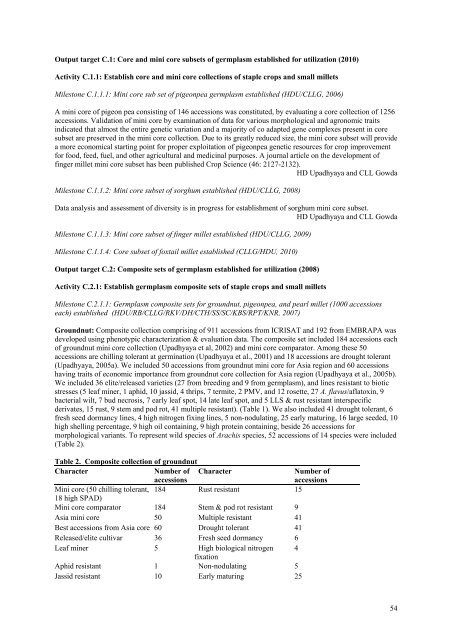ICRISAT Archival Report 2006 - The seedlings of success in the ...
ICRISAT Archival Report 2006 - The seedlings of success in the ...
ICRISAT Archival Report 2006 - The seedlings of success in the ...
You also want an ePaper? Increase the reach of your titles
YUMPU automatically turns print PDFs into web optimized ePapers that Google loves.
Output target C.1: Core and m<strong>in</strong>i core subsets <strong>of</strong> germplasm established for utilization (2010)<br />
Activity C.1.1: Establish core and m<strong>in</strong>i core collections <strong>of</strong> staple crops and small millets<br />
Milestone C.1.1.1: M<strong>in</strong>i core sub set <strong>of</strong> pigeonpea germplasm established (HDU/CLLG, <strong>2006</strong>)<br />
A m<strong>in</strong>i core <strong>of</strong> pigeon pea consist<strong>in</strong>g <strong>of</strong> 146 accessions was constituted, by evaluat<strong>in</strong>g a core collection <strong>of</strong> 1256<br />
accessions. Validation <strong>of</strong> m<strong>in</strong>i core by exam<strong>in</strong>ation <strong>of</strong> data for various morphological and agronomic traits<br />
<strong>in</strong>dicated that almost <strong>the</strong> entire genetic variation and a majority <strong>of</strong> co adapted gene complexes present <strong>in</strong> core<br />
subset are preserved <strong>in</strong> <strong>the</strong> m<strong>in</strong>i core collection. Due to its greatly reduced size, <strong>the</strong> m<strong>in</strong>i core subset will provide<br />
a more economical start<strong>in</strong>g po<strong>in</strong>t for proper exploitation <strong>of</strong> pigeonpea genetic resources for crop improvement<br />
for food, feed, fuel, and o<strong>the</strong>r agricultural and medic<strong>in</strong>al purposes. A journal article on <strong>the</strong> development <strong>of</strong><br />
f<strong>in</strong>ger millet m<strong>in</strong>i core subset has been published Crop Science (46: 2127-2132).<br />
HD Upadhyaya and CLL Gowda<br />
Milestone C.1.1.2: M<strong>in</strong>i core subset <strong>of</strong> sorghum established (HDU/CLLG, 2008)<br />
Data analysis and assessment <strong>of</strong> diversity is <strong>in</strong> progress for establishment <strong>of</strong> sorghum m<strong>in</strong>i core subset.<br />
HD Upadhyaya and CLL Gowda<br />
Milestone C.1.1.3: M<strong>in</strong>i core subset <strong>of</strong> f<strong>in</strong>ger millet established (HDU/CLLG, 2009)<br />
Milestone C.1.1.4: Core subset <strong>of</strong> foxtail millet established (CLLG/HDU, 2010)<br />
Output target C.2: Composite sets <strong>of</strong> germplasm established for utilization (2008)<br />
Activity C.2.1: Establish germplasm composite sets <strong>of</strong> staple crops and small millets<br />
Milestone C.2.1.1: Germplasm composite sets for groundnut, pigeonpea, and pearl millet (1000 accessions<br />
each) established (HDU/RB/CLLG/RKV/DH/CTH/SS/SC/KBS/RPT/KNR, 2007)<br />
Groundnut: Composite collection compris<strong>in</strong>g <strong>of</strong> 911 accessions from <strong>ICRISAT</strong> and 192 from EMBRAPA was<br />
developed us<strong>in</strong>g phenotypic characterization & evaluation data. <strong>The</strong> composite set <strong>in</strong>cluded 184 accessions each<br />
<strong>of</strong> groundnut m<strong>in</strong>i core collection (Upadhyaya et al, 2002) and m<strong>in</strong>i core comparator. Among <strong>the</strong>se 50<br />
accessions are chill<strong>in</strong>g tolerant at germ<strong>in</strong>ation (Upadhyaya et al., 2001) and 18 accessions are drought tolerant<br />
(Upadhyaya, 2005a). We <strong>in</strong>cluded 50 accessions from groundnut m<strong>in</strong>i core for Asia region and 60 accessions<br />
hav<strong>in</strong>g traits <strong>of</strong> economic importance from groundnut core collection for Asia region (Upadhyaya et al., 2005b).<br />
We <strong>in</strong>cluded 36 elite/released varieties (27 from breed<strong>in</strong>g and 9 from germplasm), and l<strong>in</strong>es resistant to biotic<br />
stresses (5 leaf m<strong>in</strong>er, 1 aphid, 10 jassid, 4 thrips, 7 termite, 2 PMV, and 12 rosette, 27 A. flavus/aflatox<strong>in</strong>, 9<br />
bacterial wilt, 7 bud necrosis, 7 early leaf spot, 14 late leaf spot, and 5 LLS & rust resistant <strong>in</strong>terspecific<br />
derivates, 15 rust, 9 stem and pod rot, 41 multiple resistant). (Table 1). We also <strong>in</strong>cluded 41 drought tolerant, 6<br />
fresh seed dormancy l<strong>in</strong>es, 4 high nitrogen fix<strong>in</strong>g l<strong>in</strong>es, 5 non-nodulat<strong>in</strong>g, 25 early matur<strong>in</strong>g, 16 large seeded, 10<br />
high shell<strong>in</strong>g percentage, 9 high oil conta<strong>in</strong><strong>in</strong>g, 9 high prote<strong>in</strong> conta<strong>in</strong><strong>in</strong>g, beside 26 accessions for<br />
morphological variants. To represent wild species <strong>of</strong> Arachis species, 52 accessions <strong>of</strong> 14 species were <strong>in</strong>cluded<br />
(Table 2).<br />
Table 2. Composite collection <strong>of</strong> groundnut<br />
Character<br />
Number <strong>of</strong><br />
accessions<br />
Character<br />
Number <strong>of</strong><br />
accessions<br />
M<strong>in</strong>i core (50 chill<strong>in</strong>g tolerant, 184 Rust resistant 15<br />
18 high SPAD)<br />
M<strong>in</strong>i core comparator 184 Stem & pod rot resistant 9<br />
Asia m<strong>in</strong>i core 50 Multiple resistant 41<br />
Best accessions from Asia core 60 Drought tolerant 41<br />
Released/elite cultivar 36 Fresh seed dormancy 6<br />
Leaf m<strong>in</strong>er 5 High biological nitrogen 4<br />
fixation<br />
Aphid resistant 1 Non-nodulat<strong>in</strong>g 5<br />
Jassid resistant 10 Early matur<strong>in</strong>g 25<br />
54

















